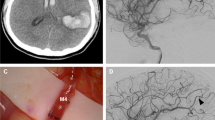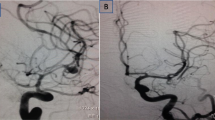Abstract
Background
The main challenge of bypass surgery of complex MCA aneurysm is not the selection of the bypass type, but the initial decision making of how to exclude the affected vessel segment from circulation. The aim of our study was to review our experience with the treatment of complex MCA aneurysms using revascularization and parent artery sacrifice techniques. Based on this, we aimed at categorizing these aneurysms according to specific surgical aspects in order to facilitate preoperative planning for these challenging surgical pathologies.
Methods
We reviewed 50 patients with complex MCA aneurysms that were not clippable but required revascularization and parent artery sacrifice. We report the individual variations of surgical techniques, highlight the technical aspects, and categorize the aneurysms based on their location and orientation.
Results
Of the 50 aneurysms, 56% were giant, 16% large, and 28% < 10 mm, but fusiform. Fourteen percent were previously treated endovascular. Four percent presented with SAH. Ten percent were prebifurcational, 60% involved the bifurcation, and 30% were postbifurcational. Both parent artery sacrifice and bypass strategies were tailored to the individual localization and anatomical relationship of the aneurysm and inflow/outflow arteries (38% proximal inflow occlusion, 42% aneurysm trapping, 20% distal outflow occlusion; 14% STA-MCA bypass, 48% interposition graft, 36%, combined/complex revascularization with reimplantation/in situ techniques). Good outcome (mRS 0–2) rates at discharge and at follow-up were 64% and 84%. Based on our analysis of individual cases, we categorized complex MCA aneurysms into six types and provide individual recommendations for their surgical exploration and treatment by revascularization and parent artery sacrifice.
Conclusion
Complex MCA aneurysms are among the most challenging vascular lesions and afford highly individualized treatment strategies. Revascularization and parent artery sacrifice provide durable results that are superior to the natural history. Our classification provides a tool for planning and pre-surgical assessment of the intraoperative anatomy of complex MCA aneurysms, helping to assume possible pitfalls.








Similar content being viewed by others
References
Amin-Hanjani S (2011) Cerebral revascularization: extracranial-intracranial bypass. J Neurosurg Sci 55(2):107–116
Amin-Hanjani S, Alaraj A, Charbel FT (2010) Flow replacement bypass for aneurysms: decision-making using intraoperative blood flow measurements. Acta Neurochir 152(6):1021–1032 discussion 1032
Amin-Hanjani S, Chen PR, Chang SW, Spetzler RF (2006) Long-term follow-up of giant serpentine MCA aneurysm treated with EC-IC bypass and proximal occlusion. Acta Neurochir 148(2):227–228
Blackburn SL, Abdelazim AM, Cutler AB, Brookins KT, Fargen KM, Hoh BL, Kadkhodayan Y (2014) Endovascular and surgical treatment of Unruptured MCA aneurysms: meta-analysis and review of the literature. Stroke Res Treat 2014:1–11
Esposito G, Dias S, Burkhardt J-K, Bozinov O, Regli L (2018) Role of Indocyanine green Videoangiography in identification of donor and recipient arteries in cerebral bypass surgery. Acta Neurochir Suppl 129:85–89
Esposito G, Regli L (2014) Selective targeted cerebral revascularization via microscope integrated Indocyanine green Videoangiography technology. In: Trends neurovascular Interv. Springer International Publishing, Cham, pp 59–64
Galkin P, Gushcha A, Chechetkin A, Krotenkova I (2017) Superficial temporal artery to middle cerebral artery bypass with interposed saphenous vein graft in patients with atherosclerotic internal carotid artery occlusive disease and impaired cerebral hemodynamics. J Neurosurg Sci 61(1):22–32
Greving JP, Wermer MJH, Brown RD et al (2014) Development of the PHASES score for prediction of risk of rupture of intracranial aneurysms: a pooled analysis of six prospective cohort studies. Lancet Neurol 13(1):59–66
Hänggi D, Steiger H-J, Vajkoczy P (2014) The role of MCA-STA bypass surgery after COSS and JET: the European point of view. Trends neurovascular Interv. Springer International Publishing, Cham, pp 77–78
Hu P, Zhang H-Q, Li X-J (2018) Double-barrel STA to proximal MCA bypass and proximal parent artery occlusion for a fusiform superior clinoidal ICA aneurysm. Acta Neurochir 160(10):1939–1943
Investigators TUJ (2012) The natural course of Unruptured cerebral aneurysms in a Japanese cohort. N Engl J Med 366(26):2474–2482
Kato N, Prinz V, Finger T, Schomacher M, Onken J, Dengler J, Jakob W, Vajkoczy P (2013) Multiple reimplantation technique for treatment of complex giant aneurysms of the middle cerebral artery: technical note. Acta Neurochir 155(2):261–269
Kawashima M, Rhoton AL, Tanriover N, Ulm AJ, Yasuda A, Fujii K (2005) Microsurgical anatomy of cerebral revascularization. Part I: anterior circulation. J Neurosurg 102(1):116–131
Mehdorn HM (2008) Cerebral revascularization by EC-IC bypass--present status. Acta Neurochir Suppl 103:73–77
Michaud K, Duffau H (2016) Surgery of insular and paralimbic diffuse low-grade gliomas: technical considerations. J Neuro-Oncol 130(2):289–298
Narducci A, Onken J, Czabanka M, Hecht N, Vajkoczy P (2018) Fluorescein videoangiography during extracranial-to-intracranial bypass surgery: preliminary results. Acta Neurochir 160(4):767–774
Nurminen V, Lehecka M, Chakrabarty A, Kivisaari R, Lehto H, Niemelä M, Hernesniemi J (2014) Anatomy and morphology of giant aneurysms—angiographic study of 125 consecutive cases. Acta Neurochir 156(1):1–10
Park W, Chung J, Ahn JS, Park JC, Kwun BD (2017) Treatment of large and Giant middle cerebral artery aneurysms: risk factors for unfavorable outcomes. World Neurosurg 102:301–312
Regli L, Esposito G (2014) Surgical decision-making for managing complex intracranial aneurysms. Acta Neurochir Suppl 119:3–11. https://doi.org/10.1007/978-3-319-02411-0_1
Rustemi O, Amin-Hanjani S, Shakur SF, Du X, Charbel FT (2016) Donor selection in flow replacement bypass surgery for cerebral aneurysms: quantitative analysis of long-term native donor flow sufficiency. Neurosurgery 78(3):332–341 discussion 341-2
Spetzler RF, Riina HA, Lemole GM (2001) Giant aneurysms. Neurosurgery 49(4):902–908
Surdell DL, Hage ZA, Eddleman CS, Gupta DK, Bendok BR, Batjer HH (2008) Revascularization for complex intracranial aneurysms. Neurosurg Focus 24(2):E21
Thines L, Proust F, Marinho P, Durand A, van der Zwan A, Regli L, Lejeune JP (2016) Giant and complex aneurysms treatment with preservation of flow via bypass technique. Neurochirurgie 62(1):1–13
van der Zwan A (2014) “How I do it:” non-occlusive high flow bypass surgery. In: Trends neurovascular Interv. Springer International Publishing, Cham, pp 71–76
Yagmurlu K, Yashar M, Kalani S et al (2016) Maxillary artery to middle cerebral artery bypass: a novel technique for exposure of the maxillary artery. World Neurosurg 100(17):540–550
Zhu W, Liu P, Tian Y, Gu Y, Xu B, Chen L, Zhou L, Mao Y (2013) Complex middle cerebral artery aneurysms: a new classification based on the angioarchitecture and surgical strategies. Acta Neurochir 155(8):1481–1491
Author information
Authors and Affiliations
Corresponding author
Ethics declarations
Conflict of interest
All authors certify that they have no affiliations with or involvement in any organization or entity with any financial interest (such as honoraria; educational grants; participation in speakers’ bureaus; membership, employment, consultancies, stock ownership, or other equity interest; and expert testimony or patent-licensing arrangements), or non-financial interest (such as personal or professional relationships, affiliations, knowledge, or beliefs) in the subject matter or materials discussed in this manuscript.
Ethical approval
All procedures performed in studies involving human participants were in accordance with the ethical standards of the institutional and/or national research committee and with the 1964 Helsinki declaration and its later amendments or comparable ethical standards.
For this type of study, formal consent is not required.
Additional information
Publisher’s note
Springer Nature remains neutral with regard to jurisdictional claims in published maps and institutional affiliations.
This work was part of an oral presentation at the 5th Annual EANS Vascular Section Meeting 2018. Nice, France
This article is part of the Topical Collection on Vascular Neurosurgery - Aneurysm
Rights and permissions
About this article
Cite this article
Wessels, L., Fekonja, L.S. & Vajkoczy, P. Bypass surgery of complex middle cerebral artery aneurysms—technical aspects and outcomes. Acta Neurochir 161, 1981–1991 (2019). https://doi.org/10.1007/s00701-019-04042-9
Received:
Accepted:
Published:
Issue Date:
DOI: https://doi.org/10.1007/s00701-019-04042-9




